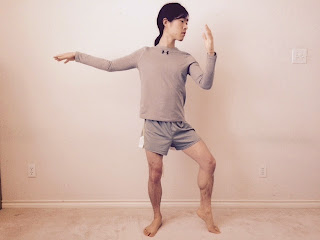How
to Apply Taichi Balance Philosophy in Yoga Poses
Introduction
Chinese Taichi, a continuously slow series of motions
controlled by breathing, is well known as an exercise of balance control. Taichi exercise is a combination of different
forms such as 24 forms, or 36 forms, or 72 forms. Each form, having its own movement
and final posture, can be composed of one inhale-exhale cycle of breathing, or
multiple cycles of inhale-exhale breathing.
Yin-Yang is the fundamental concept of Chinese Taoism. It is a Taichi symbol that represents Yin-Yang
circulation, and exchange. The more essential concepts are neutralization (中和),
and balance. The Taoism Yin-yang applies
to a Chinese lifestyle which includes nature, living, Chinese medicine, and
martial arts.
·
Yin: weak, contraction, light, less weight
·
Yang: strong, extension, heavy, more
weight
You can say Taichi exercise is a kind of continuous
movement of Yin-yang change at any moment from beginning to the end. Therefore,
Yin-yang is the core concept of Taichi practice.
Taichi
balance philosophy
Taichi
balance philosophy is based on the distribution of body weight in an
exerciser’s feet and upper body, including your arms. In Taichi’s final posture
of each form, it suggests that:
·
70% weight in yang foot, 30 % weight in Yin
foot
·
70% force in arm at opposite side of yang
foot, 30% force in arm of same side yang foot.
It
means if one’s yang foot is on the right side, the yang arm should be on the
left side. The above suggestion is the most stable and balanced posture, and
every Taichi exerciser should follow this philosophy.
There is one posture in Taichi practice, called “double
weighted”, that should be avoided. “Double weighted” means an even distribution
of weight in both feet at the final posture. All the final posture of forms should have one
foot with more weight than the other. The correct Taichi final posture of each
form should avoid “double weighted”. There are only two exceptions: at the
beginning and end of exercise, then both feet can be evenly weighted.
單鞭 Single
Whip
·
rear foot 70%, front foot 30%
·
rear arm 30%, front arm 70% (use right arm
to attack)
It
is the most stable and balanced position. In order to reach the balanced
position, raising the heel of front foot (Photo 3) can facilitate achieving the
balance goal.
 |
| Photo 1 |
 |
| Photo 2 |
 |
| Photo 3 |
Remark, the
black lines inside the picture indicate yang (more weight)Photo
1~ Photo 3 is the form of Single Wipe, Photo 3 is the final Posture
of this form.
In
contrast to the balance position, if you change to the following weight ratio
like Photo 4
·
rear foot 30%, front foot 70%
·
rear arm 30%, front arm 70%
It
is easy to lose balance as seen in Photo 4, especially if someone pulls the
front arm.
 |
| Photo 4 |
摟膝拗步 Brush Knee
Twist Stepà
right foot 70%, right
foot 30%,
right arm 30%, left arm
70% (use left arm to attack)
In
all other forms of Taichi, the finished postures have the same 70% and 30% weight
concept.
 |
| Photo 5 |
 |
| Photo 6 |
 |
| Photo 7 |
Photo
5~ Photo 7 is the form of Brush Knee Twist Step, Pic 7 is the
final Posture of this form
Apply
Taichi 70/30 balance rule in Yoga poses to improve balance
Two types of Yoga poses are usually more difficult for
the beginner: balance poses and back bends. It is beneficial to suggest the
Taichi 70/30 balance rule to beginners, and instructors should tell them how to
distribute their weight (force) at lower and upper body portions to improve
balance.
These are examples of one-legged balancing poses to
which this philosophy can be applied. The black lines signify more weight at the
foot or arm of that side compared to the other foot or arm.
 |
| Photo 8 |
 |
| Photo 9 |
 |
| Photo 10 |
You can try the following pose, One Leg Downward Facing
Dog (Photo 11~Photo 12)
1) by
evenly distributed the weight both arms(Photo 11), or
2) by
more weight on left arm (Photo 12)
In trying each method, method 1
or 2, the exerciser learns that with method 2 the right foot can be raised
higher.
 |
| Photo 11 |
 |
| Photo 12 |
Question
and Discussion
For one legged standing poses, it is clear that the 70/30
rule should be applied. For Yoga poses such as Warrior I, and Warrior II, how should
weight be distributed in the feet to confer stability? This is currently not well defined. For
example, in Warrior I and II, should 50% of the weight rest in the both the
front foot and rear foot? Can raising the front foot heel increase strength in
the rear foot for both Warrior I/II?
In Chinese martial arts (Taichi, Qigong, Shaolin), only
horse stance exhibits the 50/50 rule. For all other forms, the rear foot and
front foot never exhibit 50/50 rule.
Conclusions
Without a doubt, Yoga and Taichi are two of the most
popular exercise regimes in the world. Taking the strengths of both exercises,
and combining them is rarely discussed, and could possibly confer benefits to practitioners
of Yoga and Taichi. Yoga is more intensive in terms of stretching and strength
building, while Taichi is more relaxed and has a greater emphasis on balance.
